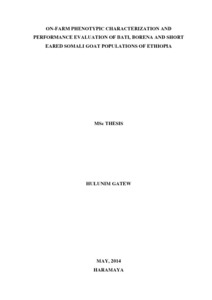Resource information
The objectives of this study were to describe the production systems, the morphological features, and growth and reproductive performances of Bati (Central Highland ecotype), Borena (Long eared Somali ecotype) and Short-eared Somali indigenous goat populations in their home tract, Ethiopia. The study covered Bati and Kalu districts for Bati goats in Oromiya and South Wollo zones (Amhara Region), respectively; Yabello for Borena goats in Borena zone (Oromia Region); and Shinille and Erer from Siti (the previous Shinille zone, in Somali Region) for Short-Eared Somali goats. For production systems description and morphological characterization of the three goat breeds a total of 601 heads of adult goats comprising 162 Bati (128 females and 34 males), 246 Borena (201 females and 45 males) and 193 Short-eared Somali (139 females and 54 males) were selected. In addition, flock monitoring were carried out and two PAs for each goat population were selected and a total of 125 household flocks (46 Bati, 48 Borena and 31 Short-Eared Somali) were monitored (beginning of April, 2013 to end December, 2013) to generate growth performance data. In terms of number, goats were the predominant species in all surveyed areas. The average (±SE) goat flock size (44.02±3.33) owned per household of Siti was significantly (p<0.05) higher followed by Borena (23.08±1.94). Source of cash was a primary objective of goat rearing in Borena and Bati areas, while milk production was ranked 1st in Siti. A range of traits: body size, fast growth rate, milk yield, reproduction rate, drought tolerance and disease resistance were some of the important performance and adaptive traits preferred by the producers across study areas. Natural pasture (shrubs and bushes) was found to be the major source of goat feed across the study areas. Age at 1st kidding in Bati, Borena and Siti areas averaged 14.98±0.24, 15.86±0.22 and 20.15±0.12 months and average kidding intervals of 7.95±0.19, 8.42±0.17 and 8.81±0.18monthswere also noted, respectively. The major challenges of goat husbandry include feed and water shortage, disease incidence and recurrent drought with different prioritization across areas. The common goat diseases reported in the study areas were pneumonia, pasteurellosis, babesiosis, anthrax and goat pox, external parasites, contagious caprine pleuro pneumonia (CCPP), coenurosis, diarrhea and pest des petit ruminants (PPR). The studied goat populations have a wide range of coat colors including plain brown (dark and light) (51.85%) which were the predominant coat color observed on Bati goats of both sexes. Meanwhile, plain white coat color was most frequently observed on Borena goats (71.54%) and only 36.27% in Short-eared Somali goat populations. Though most quantitative traits showed slightly higher average values in the Bati goats, differences with Borena goats were not significant (p>0.05),whereas Short-eared Somali goats remained significantly (p<0.05) lower for most of the body measurement characteristics. Average live weight of Bati, Borena and Short-eared Somali does were 33.97±0.4, 31.49±0.36 and 24.67±0.28kg, respectively and the corresponding values for bucks were 41.30±0.85, 40.04±1.21 and 30.62±0.67kg. Correlation coefficient was consistently highest between live weight and chest girth in both sexes across the goat populations. As a result, the stepwise multiple regression analysis revealed that chest girth was the single variable of utmost importance in the prediction of live body weight except for Short-eared Somali bucks, where body condition accounted the larger variation in body weight. Though K-Nearest Neighbor Discriminant Function Analysis classified most individuals of both sexes into their source population in all areas, the highest hit rate was found in Borena does (96.02%) and in Short-eared Somali bucks (94.4%). The canonical discriminant analysis depicted the largest Mahalanobis' distance between Borena and Short-eared Somali goats while the least differentiation was observed between Bati and Borena goats. Non-genetic factors (sex and parity of dam) and genetic factor (goat ecotype) had significant (p<0.05) effect on the average live weight and daily weight gain of young goats at different ages. However, type of birth had non-significant effect on daily weight gain of all goat types and on live weight of Short-eared Somali kids at different ages (birth, 30, 90 and 180 days). Bati kids had the heaviest overall live weight at birth (2.70±0.05kg) followed by Borena (2.42±0.05 kg). Therefore, the growth performance of these goat ecotypes is encouraging and can be further improved genetically through selection.


